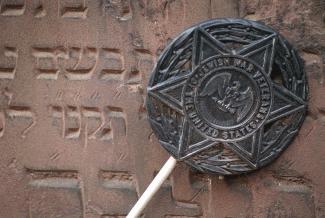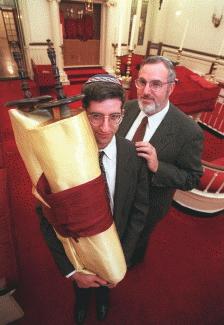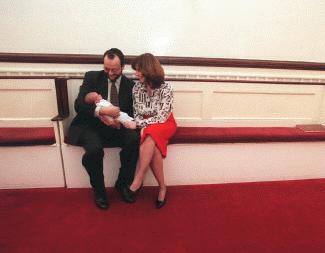
Nation's oldest Jewish congregation traces roots to Sephardic exiles
A story from 1997 by the Associated Press
Storm-tossed in the Caribbean and captured by pirates, 23 Jews fleeing oppression in Brazil landed in 1654 in what is now New York, and formed America's first Jewish congregation.
Descended from survivors
of the Spanish Inquisition, these pioneer American Jews called themselves
the "remnant of Israel" -- in Hebrew, Shearith Israel. "It's a wonder there
was a remnant at all," says Rabbi Marc Angel, spiritual head of the synagogue
on Central Park West that has been the congregation's home since 1897.

A marker denotes the gravesite of a Jewish Revolutionary War veteran at Congregation Shearith Israel's first cemetery, also the nations first Jewish cemetery, consecrated in 1656.
To mark the temple's centennial this year, Shearith Israel has been searching for descendants of 1897 member families for a reunion. Meanwhile, the congregation -- whose members have included a U.S. Supreme Court justice, three founders of the New York Stock Exchange and poet Emma Lazarus -- continues to welcome and succor survivors of persecution. "We lost 80 members of our family, everyone except me and my mother's cousin, who is here," said Mirella Axelrad, whose family fled Europe during the Holocaust. She now lives in Bolivia and visited the synagogue for her infant grandson's recent circumcision. Her eyes teared up, then creased into a radiant smile as she spoke of the baby. "He's safe here," she said in her native Italian.
The congregation of 600 families traces its roots to Jews exiled from Catholic Spain and Portugal in the 1500s. Some eventually wound up in Brazil, under more tolerant Dutch colonizers. But a century later, the Portuguese ousted the Dutch, and Brazil's Jews fled in search of a safe haven again. The 23 who got lost in the Caribbean and fell into the hands of buccaneers were rescued by a French vessel and finally made it to the Dutch colony of New Amsterdam on the Hudson River. There, they and their descendants worshiped in rented space in lower Manhattan until 1730, when they turned an old grist mill into a synagogue -- the first in the American colonies. Three more sites followed before the congregation built its present home, facing Central Park, on a former duck farm. The original "23 souls, big and little," as a Dutch document called them, grew into a religious community that has served some prominent New Yorkers. One of them, Judith Kaye, chief judge of the Court of Appeals, the state's highest court, has worshiped at Shearith Israel for 30 years. "My moment of greatest joy came in the temple when the Torah was placed in my arms for the first time," the judge said, referring to the sacred scrolls of scripture. "Women don't usually carry the Torah."

Rabbi Hayyim Angel, holding a Torah dating back to the American Revolution, and his father, Rabbi Marc Angel, are the spiritual leaders of the Congregation Shearith Israel
Benjamin Cardozo, a predecessor of hers who went on to serve on the U.S. Supreme Court, also was a member of the congregation. So was Ms. Lazarus, who penned the lines on the base of the Statue of Liberty: "Give me your tired, your poor ..." New York now has the largest Jewish population of any city in the world, at more than 1 million. But when the first 23 Jews docked in New York, they were hardly met with open arms. The Dutch governor, Peter Stuyvesant, described them as "very repugnant" to the magistrates and people of his colony. "He finally told them they could stay," Rabbi Angel said, "but they had to be unobtrusive, and the governor said that if they got sick or were in need, they had to take care of their own."
One of them, Asser Levy, chafed at the idea that he paid taxes to the Dutch but was allowed none of a resident's privileges or duties, such as guarding the city gates. In one of America's earliest civil rights cases, Levy demanded -- and won -- the right to do guard duty. Largely, however, the small religious community survived because members got along with the non-Jewish community and with later-arriving Jews of different backgrounds, Rabbi Angel said. The rabbi noted that in colonial times, Ashkenazi Jews from central Europe were embraced by Shearith Israel's Sephardic Jews, whose roots are Mediterranean.

Parents Jadranka and Roberto Salama cuddle their newborn son following his circumcision at the synagogue
To this
day, the congregation follows Sephardic tradition during services, but welcomes
worshipers of varied backgrounds, including more secular Reform Jews. "We
follow basic tradition, but we're not rigid," said Rabbi Angel's son, Hayyim,
27, also a rabbi. "About 50 years ago, if a man walked into the synagogue
without a hat, he'd be sent to the back row. We don't do that now," said the
younger rabbi. "We train them instead."
Louis N. Levy, Founder of the Foundation for the Advancement of Sephardic Studies and Culture was the co-founder of Sephardic House at Congregation Shearith Israel.

